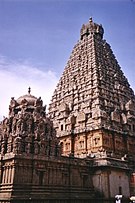Tamil history from Sangam literature
This article possibly contains original research. (September 2007) |
| Part of a series on |
| History of Tamil Nadu |
|---|
 |
| Topics in Tamil literature | |
|---|---|
| Sangam Literature | |
| Five Great Epics | |
| Silappatikaram | Manimekalai |
| Cīvaka Cintāmaṇi | Valayapathi |
| Kundalakesi | |
| Bhakthi Literature | |
| Tevaram | Divya Prabandha |
| Tirumuṟai | |
| Tamil people | |
| Sangam | Sangam landscape |
| Tamil history from Sangam literature | Ancient Tamil music |
Sangam literature is one of the main sources used for documenting the early history of the ancient Tamil country. The ancient Sangam poems mention numerous kings, princes and poets, the existence of some of whom have been confirmed through archaeological evidence. Sangam literature is still the main source for the early Cholas, the Pandyas and the Cheras.
Age of Sangam[]
Sangam was the ancient academy of Tamil poets and authors in the city of Madurai in South India under the patronage of the Pandya kings. It is difficult to estimate the exact date of these Sangam works. Some scholars suggest the historical Sangam literature era spanned from c. 300 BCE to 300 CE.[1]
See also[]
References[]
- ^ Singh, Upinder (2008). A History of Ancient and Early Medieval India: From the Stone Age to the 12th Century. Pearson Education India. ISBN 9788131711200.
- Nilakanta Sastri, K.A. (1955). A History of South India, OUP, New Delhi (Reprinted 2002).
- South Indian Inscriptions - http://www.whatisindia.com/inscriptions/
- Nagaswamy, R, Roman Karur, Brahadish Publications (1995)
- Krishnamurthy, R Non-Roman Ancient Foreign Coins from Karur in India, Garnet Publishers, Chennai
- Codrington, H. W. A short History of Ceylon, London (1926) (http://lakdiva.org/codrington/).
- N. Parameswaran Tamil Guardian 12 October 2005 [1]
External links[]
Categories:
- Tamil-language literature
- Chola dynasty
- Sangam literature
- Tamil history
- Historiography of India
- Indian poetics
- Cultural history of Tamil Nadu
- Tamil stubs